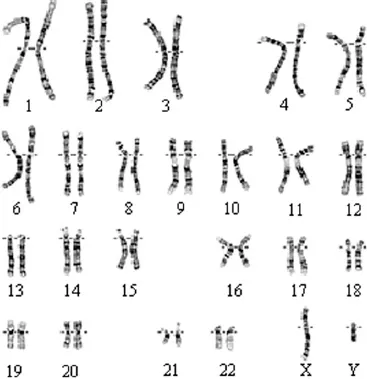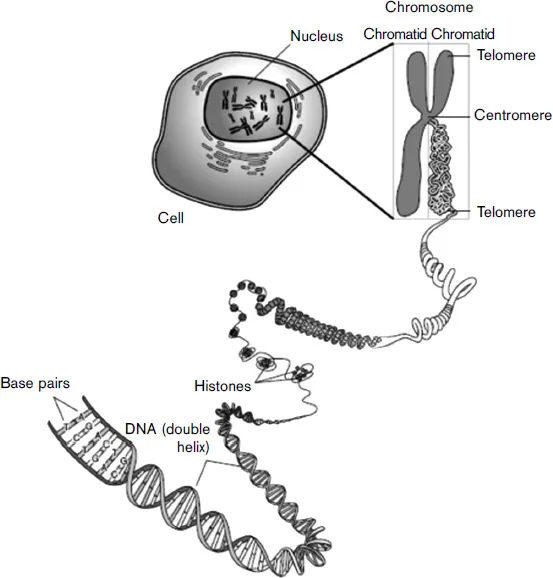![]()
Chapter 1
Genetics is not complicated
John Burn MD FRCP FRCPCH FRCOG FMedSci
Professor of Clinical Genetics, Newcastle University
Newcastle upon Tyne, UK
Background
There is something wonderfully simple about writing instructions in a universal alphabet of only four letters that provide descriptive words, all three letters long, for the amino acids which make up the proteins of the body or for the punctuation marks (Table 1). The challenge for the clinician is connecting the basic anatomy of genes through to the patient who just told you that they are the third person in the family to have a particular illness, or worse still that they are worried about their risk of a syndrome you have never heard of. Added to this longstanding cause of anxiety is the realisation that there may now be a genetic test for this condition but you are not sure how to organise it.
| Table 1. Genetic code - some examples. |
| Amino acid | DNA base coding sequence |
| Alanine | GCT, GTT, GTA, GCG |
| Methionine | ATG |
| Isoleucine | ATT, ATC, ATA |
| Lysine | AAA, AAG |
| Stop codon | TAG, TGA, TAA |
Clinicians approach problems on a ‘need to know’ basis and remember information best when it relates to a clinical problem. These introductory pages are a reminder of the basic language needed to make sense of the later sections and are not intended to be comprehensive. A reading list of good genetics textbooks and useful reference sources is provided at the end of the chapter.
Genetic disorders are not rare
There is no doubt that there are many vanishingly rare disorders with a genetic basis, upwards of 6,000 of them. My favourite at the moment is a dominant trait called Birt Hogg Dube syndrome which carries a risk of renal cancer. The fact that there are so many rare disorders contributes to the assertion that this is not a rare problem. A survey in a Canadian population added together all the people who presented with a single gene defect or a major malformation and discovered that one in 20 people will have developed or died from a genetic disorder by the age of 25 years. Add to this the later onset conditions like hereditary breast and colon cancer and the fact that a major disease in a younger person will have a big impact on their whole family and associated clinicians, and it is obvious that, collectively, genetic disorders are very common, especially in developed countries where infectious diseases and malnutrition present fewer problems.
Chromosomes
Long before the recognition of the importance of DNA, early microscopists recognised that the thread-like ‘coloured bodies’ or chromosomes visible in the nuclei of dividing cells (Figure 1) clearly had something to do with transmission of hereditary information. Surprisingly, it was not until 1956 that it was established that human cells contain 46 chromosomes, by which time the anatomy had become clearer.
Figure 1. Normal male human karyotype.
Structure
Each of the 23 pairs of chromosomes is a long DNA molecule, coiled around histone proteins, then coiled and coiled again (Figure 2). When we see the familiar karyotype (Figure 1) in textbooks we are looking at a brief moment when the chromosomes have become supercoiled and are in a duplicated state. The cells are poisoned with colchicine to hold them at this point, when they are most easily examined and identified, based on the characteristic banding pattern produced by the physical and chemical interaction of the chromosomes with Giemsa stain.
Figure 2. Chromosome structure. Reproduced under the GNU Free
Documentation License (GFDL).
(http://creationwiki.org/GNU_Free_Documentation_License).
It is this banding which gives rise to the positional nomenclature of genes within chromosomes. For example the APC gene is positioned at 5q21. This means that it is on chromosome 5, on the long arm of the chromosome (q denotes locations on the long arm of a chromosome, and p locations on the short arm). 21 denotes band 1 in region 2, these locations being defined by the visible banding of the chromosome. This is shown in Figure 3.
Figure 3. Ideogram of chromosome 5.
In years to come, the ‘old fashioned’ photograph of matching pairs of chromosomes will give way to a synthetic picture constructed by breaking up a person’s DNA and hybridising it to short fragments of the genome arranged on a slide. By competing the patient’s DNA with a population sample it becomes possible to identify missing bits and extra bits. This technique is rapidly falling in price and is extremely sensitive - in some cases too sensitive. It turns out that humans have chunks of DNA which can be repeated multiple times without clinical effect, so in future there will be much debate about ‘chromosomal variants of uncertain significance’.
Conversely, tiny deletions and duplications which are significant will potentially lead us to genes of clinical importance in certain clinical situations. The most dramatic example in colorectal surgical history was the case report of a man with a chromosome 5 deletion and learning disability who also suffered from familial adenomatous polyposis (FAP), an observation which led to the identification of the location of the causative gene and shortly thereafter the APC gene itself.
Genes
Often a gene and the protein that it codes for will have the same name. In order to differentiate them italics are used when referring to the gene, and not when referring to the resulting protein (e.g. the APC gene codes for the APC protein).
We use the word ‘gene’ in two interchangeable ways. It can refer to a section of one of the 23 pairs of chromosomes or it can refer to a faulty segment of DNA which results in a disease. Thus, we speak of the K-ras gene, or more precisely the K-ras gene locus and we speak about the ‘gene’ responsible for FAP, which refers to a defective copy or allele of the APC gene on chromosome 5. When we use the terms dominant and recessive we are discussing alleles at a particular locus.
Dominant or recessive?
When Mendel solved the puzzle of inheritance with his pea plants, he coined the terms dominant and recessive to describe the two basic types of genes, or ‘factors’ as he called them. As the name suggests, a dominant gene manifests itself in the presence of a recessive gene. The effect of recessive genes, on the other hand, are only seen when there are two copies present.
The situation is further confused by the use of the term dominant to refer to a clinical phenotype or syndrome. Until his death in 2008, Victor McKusick spent over 40 years compiling his textbook, Mendelian Inheritance in Man, which has become a free online resource (www.ncbi.nlm.nih.gov/sites/entrez?db=omim). The many thousands of dominant and recessive phenotypes are catalogued along with links to causative genes where known. Many of these phenotypes earn their title on the basis of inheritance pattern. Classically, a dominant trait will be transmitted to half, on average, of the offspring of an affected individual. If a characteristic pattern runs through three generations, this is taken as strong evidence of a dominant gene defect. Recessive gene defects are characterised by occurring in one generation, affecting on average one in four of siblings. This is because each parent is a carrier and each has a half chance of passing on the defective gene so a child has half of a half, or a quarter chance, of receiving two defective copies and developing the disease.
In the field of colon cancer FAP is a classic dominant and mutY human homologue (MYH)-associated polyposis or MAP is a classic recessive. It is of historical interest that the term ‘familial’ used to be synonymous with what we now call recessive traits while ‘hereditary’ refers to dominant traits. The surgeons responsible for coining the term FAP were clearly unaware of this usage; it should have been HAP!
When family trees are examined in close-up many exceptions emerge. The most obvious in these days of reduced family size and rare cousin marriage is that most examples of recessive and dominant inheritance will be isolated cases. Many dominant traits which are not compatible with reproduction are never seen in two generations.
New mutations
Some, or in some conditions all, cases occur as new mutation...



